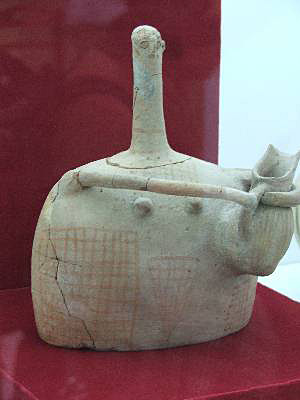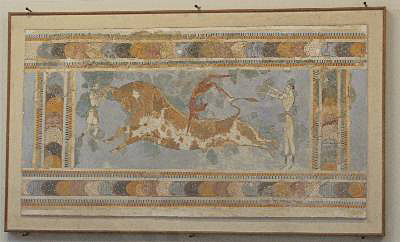 |
 |
 |
 |
The Minoan civilization, centered on the island of Crete,
lasted from about 3000-1100 BC and peaked in the middle of the second
millennium BC. The name derives from Minos, either a great ruler or the name
of a dynasty. Minoan advances included trade throughout the region, writing
in hieroglyphics and later the still-undeciphered language Linear A,
building and management of large palaces, and leaving a trove of art, in the
form of pottery and especially frescoes. The current theory is that the huge
volcanic eruption that decimated the island of Santorini might have caused a
tsunami that began the decline of Minoan culture on Crete, sixty nautical
miles away.
This early rhyton or drinking vessel is called the Goddess of Myrtos (2600-2300 BC). Water was considered sacred to the Minoans and many of the finds remaining from this civilization are libation (drinking) vessels. This lady's long skinny arms and neck are typical of the endearing and cheerful art objects characteristic of this Bronze Age civilization. |
| A huge palace survives at Knossos, near
Crete's capital of Iraklion. The palace, built around 1700 BC, with its
1100 rooms and corridors, is the legendary center of the myth of the
Minotaur, half-man, half-bull, kept in the labyrinth of corridors.
The palace was festooned with frescoes like this depiction of friendly dolphins in the Queen's Megaron (apartments). The brightly-restored (and somewhat controversial) frescoes at the site are copies; the originals are in the protection of the archaeological museum in Iraklion. The Queen's apartment included a private bathroom and a clay bathtub.
|
|
| Bathing was also an important ritual in the Throne Room,
festooned with a fresco of griffins, a mythological creature with a lion's
body and a bird's head. The Throne Room was furnished with a stone throne
for a priestess and was probably used as a shrine.
The Minoans had a fine command of hydrostatic principles, demonstrated by an ancient aqueduct at Knossos. Not only does Knossos contain the world's oldest throne, the site boasts the world's oldest flushing toilet. So apparently it contains both of the world's oldest thrones. |
|
| Because the language of the Minoans is still a
mystery to archaeologists and historians, everything we know about everyday
life in the Minoan civilization comes from the art found on pottery and
frescoes. One of the more unusual sports was bull-leaping, which is depicted
in this original fresco now housed in the archaeological museum.
The athlete uses a bull in a similar way to today's gymnastics on what we call a "horse", flipping over its back and landing into the waiting support of a spotter. In a display of early egalitarianism, spotters and even the athletes were often women. If you'd like to know exactly how bull-leaping was done, click here (the page will open in a new window.) |
 |